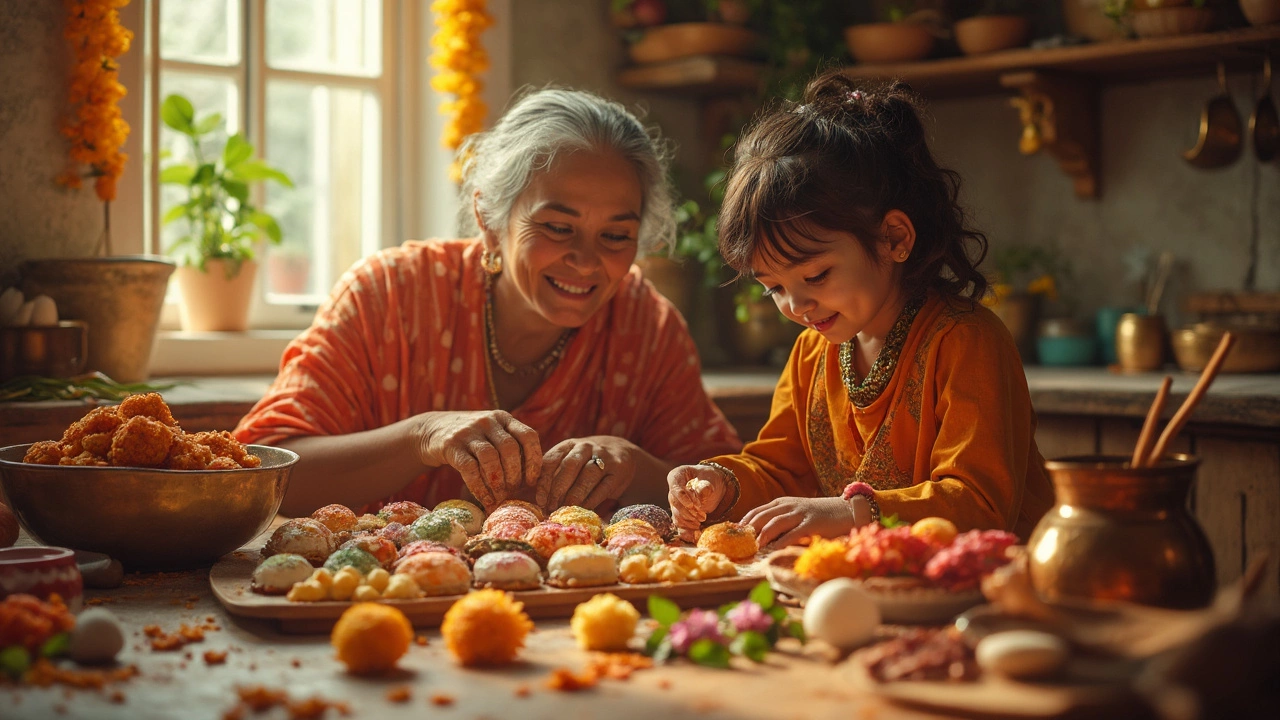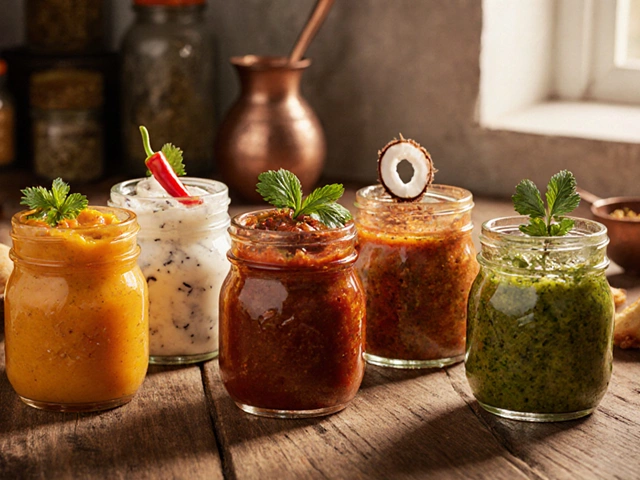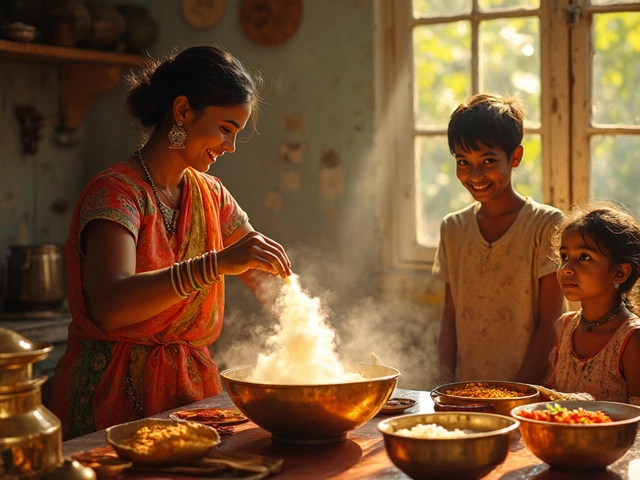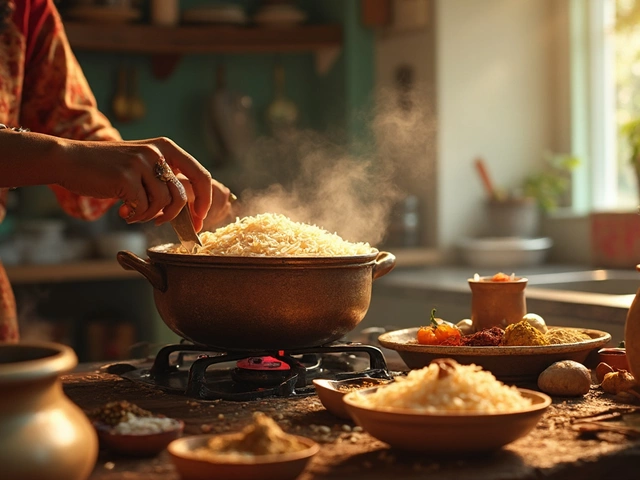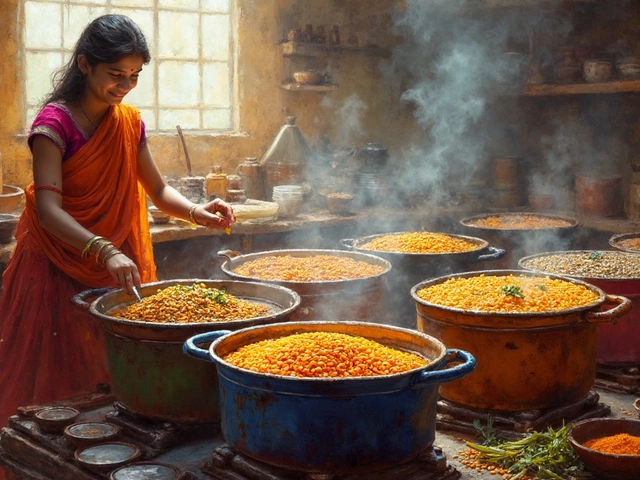No Indian festival, wedding, or even a regular family get-together is complete without something sweet on the table. When people ask about India's traditional sweet dish, you'll probably hear a dozen different answers, and honestly, they're all right—India's got hundreds of classics, not just one. But ask around, and you'll see names like gulab jamun and jalebi come up again and again. They're the first sweets to disappear at any party, and for a good reason.
Traditional mithai isn't just about taste—it's about memories, togetherness, and that rush of sweetness after a spicy meal. Some sweets take days to make, need special equipment, or even have secret family tweaks passed down for generations. Don't be intimidated though: plenty of these recipes can be tackled in your own kitchen with simple ingredients. The best part? They're a hit with both kids and grown-ups—trust me, my own Jasper and Leona keep asking for seconds whenever we make them at home.
If you've ever wondered what makes an Indian sweet truly 'traditional,' or which ones are must-tries, you're not alone. Get ready to dive into the colorful world of mithai, where there's always a new treat waiting for you around the corner. And yes, you'll get tips on making them too, so you're set for your next celebration—or just a midweek craving fix.
- What Makes a Sweet Dish 'Traditional' in India?
- The Iconic Sweets: Gulab Jamun, Jalebi, and More
- Regional Favorites and their Stories
- How to Make Classic Mithai at Home
- Fun Facts and Handy Tips for Lovers of Indian Sweets
What Makes a Sweet Dish 'Traditional' in India?
So what exactly puts a sweet into the "traditional" category in India? Well, first off, it's all about history. Some Indian sweets—like peda and barfi—pop up in records going back hundreds of years. These desserts have been part of religious rituals, royal feasts, and street food stalls way before instant cake mix was a thing.
The ingredients really tell the story. Most traditional Indian desserts use basics like milk, sugar, ghee (clarified butter), and nuts. Spices like cardamom, saffron, and rose water are pretty common, too. You'll notice that almost every family has at least one mithai recipe with its own twist, but the core ingredients barely change.
There’s also a cultural side to tradition. Classic sweets are tied to festivals—Laddoo for Ganesh Chaturthi, gujiya during Holi, and soan papdi for Diwali. If you go to any Indian city or village, you’ll find certain sweets that everyone connects with their local identity.
- Gulab jamun and jalebi: Consistently top the list at weddings and parties.
- Kaju katli: Almost always gifted during Diwali.
- Rasgulla: Huge in West Bengal, so much that it stirred a state rivalry with Odisha about its true origin.
Traditional doesn’t have to mean age-old, though. Sweets like mysore pak and milk cake feel ancient, but were actually invented by chefs in royal kitchens just one or two centuries ago. Most authentic mithai is made fresh, without artificial flavours or shortcuts.
Want a quick snapshot of iconic ingredients? Here you go:
| Ingredient | Common Sweets |
|---|---|
| Milk or Khoya | Barfi, rasgulla, peda |
| Besan (gram flour) | Laddoo, mysore pak |
| Sugar Syrup | Jalebi, gulab jamun |
| Ghee | Mohanthal, besan laddoo |
So, if a sweet dish is made from simple ingredients, has a story, is tied to a celebration, and has stood the test of time, you can bet it’s truly traditional. The best part is, you don’t have to be a pro chef or need fancy tools to start with these Indian recipes. Just a little patience and a lot of curiosity get you far.
The Iconic Sweets: Gulab Jamun, Jalebi, and More
Let's get real—if you ask most people about the first Indian sweets that pop into their head, you're probably going to get two answers: gulab jamun and jalebi. These treats are pretty much everywhere, from street stalls to fancy wedding buffets, and each has its own fan club.
Gulab jamun is like the comfort food of Indian desserts. They're soft, round balls made from khoya (which is basically thickened milk) mixed with a bit of flour. They're fried until golden, then soaked in a warm, cardamom-flavored sugar syrup. Most folks eat them hot and gooey, but they're still amazing straight from the fridge. The interesting part? Khoya is super rich in protein and calcium, making these a tiny bit less guilty than they look—well, if you ignore the sugar syrup.
Then there's jalebi, which is basically the Indian answer to funnel cake, but crispier and with a citrusy twist. Jalebi is made by deep-frying a fermented batter into spirals and dunking them in sugar syrup, so they're sticky, sweet, and have that perfect crunch. In some parts of India, people eat jalebi with milk as a breakfast treat, which honestly sounds wild but totally works if you like your mornings extra sweet.
But the traditional sweets train doesn't stop there. Here are a few more must-try favorites:
- Rasgulla: Soft, spongy balls made from chenna (fresh paneer) soaked in super light syrup. Born in Bengal, these are famous for their bounce and mild sweetness.
- Barfi: Square or diamond-shaped blocks made from milk solids, sugar, and often flavored with nuts, cardamom, or rosewater. There's even a pistachio version—kids love the colorful ones.
- Ladoo: Round, bite-sized sweets usually made from gram flour, coconut, or semolina, and loaded up with ghee. Every region has its own spin on ladoos, but they all disappear fast at celebrations.
- Kaju Katli: This one’s for the nut lovers—thin, smooth slices made mainly from cashew paste and sugar, topped with edible silver foil for that festive look.
Quick heads-up: if you’re serving any of these Indian desserts at home, expect them to vanish before you can say 'save me one.' For folks who love numbers, look at how popular some of these sweets are during key Indian festivals:
| Sweets | Diwali Sales (Tons/Year) |
|---|---|
| Gulab Jamun | 120,000 |
| Jalebi | 90,000 |
| Barfi | 85,000 |
So, whether you love gooey, crunchy, or nutty sweets, there’s a classic Indian mithai ready to make you fall in love. And honestly, trying to pick a favorite is almost impossible—trust me, I’ve tried. Just enjoy the sugar rush and make room for extra helpings.
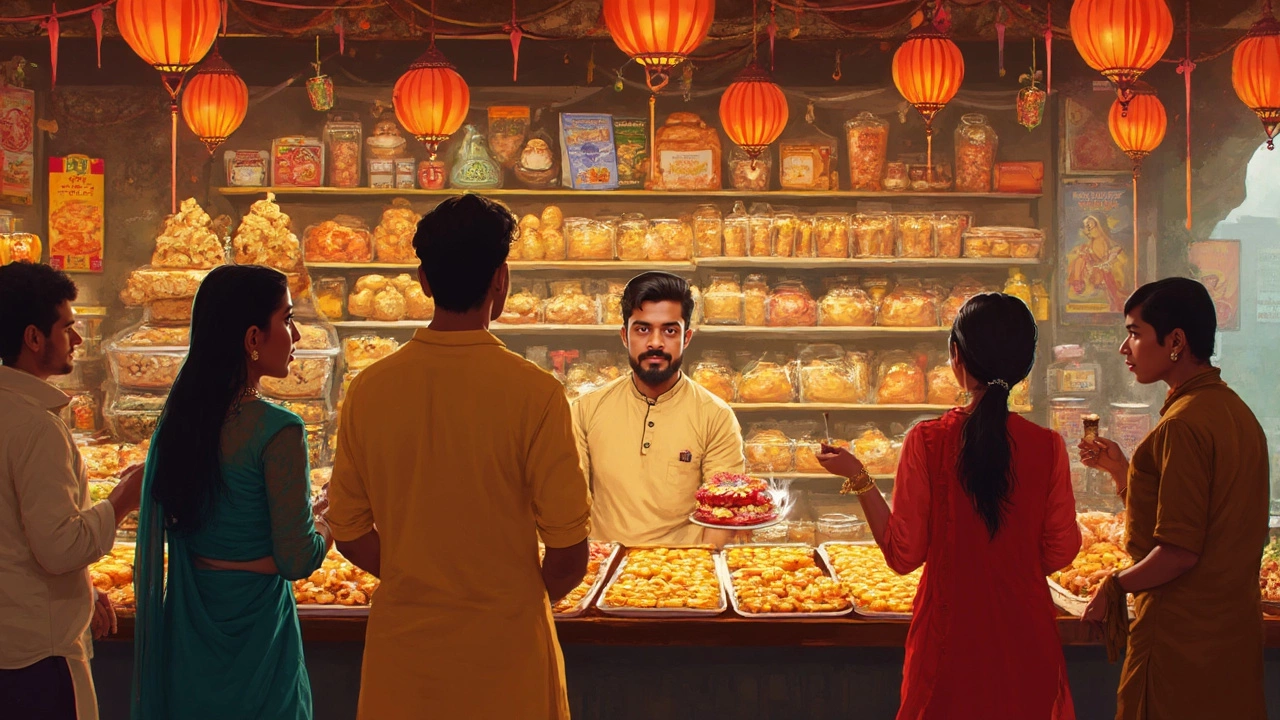
Regional Favorites and their Stories
India’s love for Indian sweets really shows in the way every state has its own star dessert. No two places make their mithai the same way. The sweets you get in Kolkata taste and look completely different from the treats you’ll find in Rajasthan or Kerala.
Bengal is famous for its creamy, juicy rasgulla. These spongy cheese balls soaked in sugar syrup actually came from Odisha but were made super popular by sweet shops in Kolkata. You’ll even find heated arguments about who truly invented it! Either way, there’s no denying it’s a favorite across east India.
Travel to north India, especially Punjab and Uttar Pradesh, and laddoo is everywhere. Besan laddoo, made from roasted chickpea flour, is a common pick for Diwali and is one of those traditional sweets that every kid grew up eating at grandma’s house. Punjabi pinni is another treat, loaded with ghee, wheat flour, and nuts—meant to give warmth in cold winters.
Move down South and you'll be greeted by Mysore Pak, a rich, melt-in-the-mouth sweet invented in the kitchens of the Mysore Palace. It’s made from gram flour, ghee, and sugar, and is so addictive you can’t stop at one piece. In Tamil Nadu, payasam (a sweet milk pudding) ends almost every meal on a happy note. Coconut, cashews, and cardamom are non-negotiable here.
In western India, especially Maharashtra and Gujarat, shrikhand is a hit. This sweetened, strained yogurt gets a boost from saffron and cardamom. It’s thick, creamy, and honestly, a lifesaver when the summer gets brutal. And you can’t skip modak in Maharashtra, steamed or fried, stuffed with sweet coconut—especially during Ganesh Chaturthi.
Here’s a quick look at some regional mithai and their origins:
| Region | Famous Sweet | Main Ingredient |
|---|---|---|
| Bengal/Odisha | Rasgulla | Cottage Cheese (Chenna) |
| Punjab/UP | Laddoo | Chickpea Flour (Besan) |
| Tamil Nadu/Kerala | Payasam | Milk, Rice, Coconut |
| Karnataka | Mysore Pak | Gram Flour, Ghee, Sugar |
| Maharashtra | Modak | Rice Flour, Coconut, Jaggery |
| Gujarat/Maharashtra | Shrikhand | Yogurt, Saffron |
Getting to know these classics helps you understand why Indian desserts come in so many shapes, colors, and flavors. The stories behind each sweet are just as interesting as the taste. Next time you taste a gulab jamun or rasgulla, know that you’re eating a part of someone’s family tradition—or maybe a centuries-old royal recipe!
How to Make Classic Mithai at Home
So you want to tackle traditional Indian sweets in your own kitchen? It’s not as tricky as it sounds. Sure, some recipes feel like a magic trick the first time, but most classic mithai just need a few everyday ingredients and a bit of patience. The real trick is to keep an eye on those tiny details—because that’s where even grandma never cuts corners.
Let’s take gulab jamun, for example. It’s basically fluffy dough balls, soaked in sugar syrup. The dough can be made from khoya (reduced milk), milk powder, or even paneer. Most home cooks find milk powder the easiest:
- Mix 1 cup milk powder, 1/4 cup all-purpose flour, and a pinch of baking soda.
- Add just enough milk to make a soft, smooth dough. Don’t overwork it, or your jamuns get dense.
- Roll into small balls, making sure there aren’t any cracks.
- Fry in medium-hot oil (not too hot, or they’ll burn outside before cooking inside).
- Drop into warm sugar syrup (water + sugar + a hint of cardamom) and leave to soak.
Want to make jalebis, those crunchy, syrupy spirals? All you need is all-purpose flour, a bit of yogurt, and a spoonful of cornflour for crispiness. Mix them up, let the batter ferment a few hours, pipe it into hot oil, and straight into syrup. The hardest thing here is making neat spirals—kids love trying, but don’t stress if they look a little wild.
| Mithai | Main Ingredients | Prep Time (approx) |
|---|---|---|
| Gulab Jamun | Milk powder, flour, sugar | 45 min |
| Jalebi | Flour, yogurt, syrup | 1.5 hrs |
| Barfi | Condensed milk, sugar, ghee | 30 min |
| Ladoo | Besan, ghee, sugar | 40 min |
The best piece of advice comes from chef Sanjeev Kapoor, who says,
"Don’t chase the perfect look. Flavor and freshness matter way more when it comes to Indian desserts. Even the messiest burfi can vanish in minutes if it tastes great!"
Always use good quality ingredients—lousy ghee or stale nuts will show up instantly in the final taste. Most mithai recipes can be halved or doubled, so you never end up with leftovers nobody wants (as if that's a thing!). If you’re new, start with barfi or ladoo—the steps are straightforward, and you’ll get the hang of timing and texture without breaking a sweat.
Once you're comfortable, experiment with add-ons: a few saffron strands, chopped pistachios, or even a dash of rose water can make a massive difference. And if you’re pressed for time or just testing waters, there are shortcut recipes that use condensed milk or microwave tricks. Homemade Indian desserts might even turn into your new party trick.
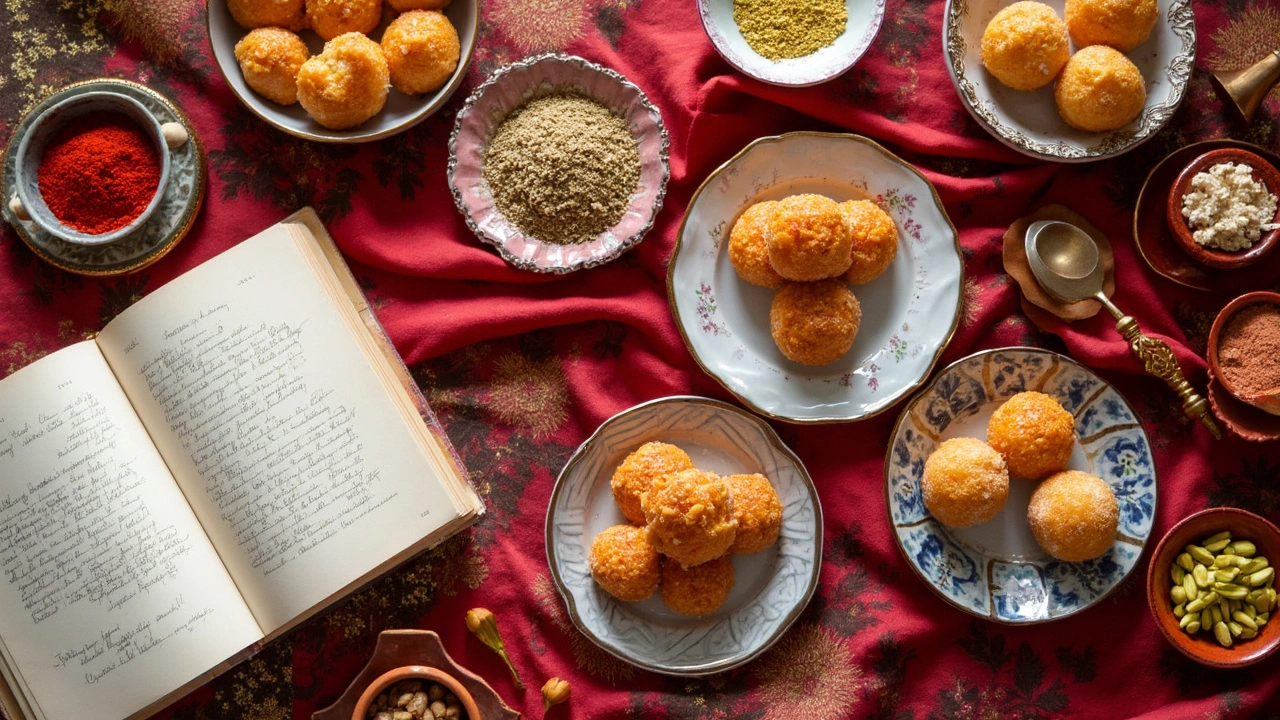
Fun Facts and Handy Tips for Lovers of Indian Sweets
It’s wild how much history and science you’ll find in Indian sweets. For example, did you know rasgulla has roots going all the way back to at least the 12th century in Odisha? And jalebi? It’s mentioned in ancient Persian texts before it even became a street food legend in India.
Sweets aren’t just sugar and ghee; they’re loaded with meaning. Take laddus—these little round treats were handed out during festivals because round shapes are considered lucky and complete. In weddings and big celebrations, mithai like gulab jamun often means good vibes and sweet beginnings for families.
Here’s something cool: there’s actually a dedicated sweet for almost every Indian festival. Modak for Ganesh Chaturthi, gujiya for Holi, barfi for Diwali—the list keeps going. My kids totally look forward to the treats more than the actual holiday rituals. I get it!
"The tradition of mithai-sharing is so strong that in some regions, offering sweets is just as important as the ceremony itself." – The Indian Express, Food Edition
If you want your mithai to turn out perfect, here are some tips from hands-on experience and advice from good old Indian aunties:
- Always use fresh ingredients—especially milk, because it can make or break homemade khoya or chenna.
- Pay attention to syrup: For things like jalebi or gulab jamun, the sugar syrup needs to be the right thickness (not too runny, not thread-thick) or your sweets can get soggy or won’t soak properly.
- Flavor matters: Cardamom, saffron, and even rose water add real depth, so don’t skip them even if you’re tempted.
- If you’re deep frying (like for gulab jamun or balushahi), always use a medium heat. Too hot and they brown outside but stay raw inside—too cold and they’ll soak up oil.
- Short on time? Try quick versions like instant peda or microwave barfi. They’re beginner-friendly and pretty satisfying for midweek cravings.
Get a kick out of numbers? Here’s a quick look at just a handful of festival-special sweets and their associated holidays:
| Sweet | Occasion |
|---|---|
| Modak | Ganesh Chaturthi |
| Gujiya | Holi |
| Laddu | All festivals & celebrations |
| Barfi | Diwali |
| Kheer | Eid, birthdays |
Don’t let the long ingredient lists or fancy pictures scare you off—start small, experiment, and you’ll soon have your own go-to Indian desserts. And by the way, don’t stress about perfection. Most aunties will tell you, it’s the love and the saffron that matter most!
- Poplular Tags
- Indian sweets
- mithai
- Indian desserts
- traditional sweets
- Indian recipes





